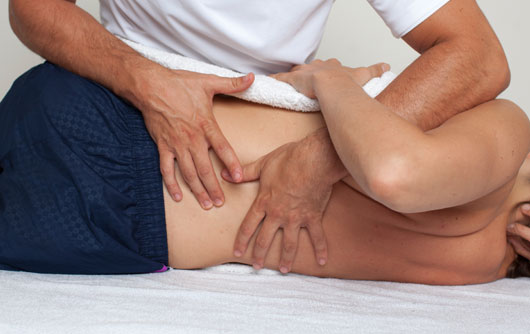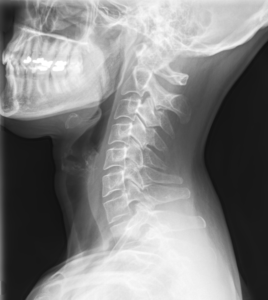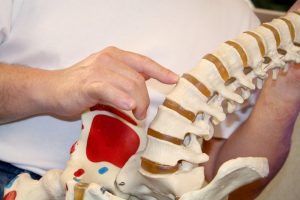Does Manipulation Move Bones Back “Into Place”? (Part 1)

I hear all the time from patients that “my neck is out” or “my back is out.” I understand the patient is stating they feel they could benefit from spinal manipulation or they’re experiencing pain in that area. It is usually a perception of something being stuck, not moving properly, or pain with movement of the spine. However, the notion that bones move “out of place” is an outdated concept in dire need of correction. Unfortunately, it is one that continues to be propagated by chiropractors and other medical professionals alike.
I understand why it’s such a common notion. It was the prevailing thought for the mechanism of injury decades ago. In addition, it is continually slipped into countless conversations in chiropractic and physical therapy clinics across the nation on a daily basis without so much as a second thought. There is even the chiropractic term, “subluxation,” that has been historically characterized as a spinal bone that has moved out of position relative to the adjacent vertebrae. However, research is showing that this is simply not true. After reading this, I hope you are convinced that bones do NOT simply move out of place on their own. (Major trauma or accidents, not withstanding.)
Joint Mechanics
First, it must be stated that it’s very difficult to make absolute statements about the mechanical and neurologic effects of spinal manipulation or adjustments, as research evidence does not exist to support such positions. In addition, there is continuously new research being performed, that may someday prove our current understanding to be limited or even entirely incorrect. The following is a summary of the current best theory of joint biomechanics and may be proven false at some point in the future as the understanding of joint function improves.
Joint movement is very complex. It typically involves about a dozen muscles that cross the joint, acting on the bones and creating the movement. It also involves the many ligaments and often a joint capsule that support the joint, not to mention the actual shape and structure of the joint surfaces which heavily influence which motions can occur at that joint. (If you ask one of my former students from the Anatomical Kinesiology courses I’ve taught, they will probably recall nightmares about learning joint movement.) It is not a simple topic!
Chiropractic Adjustment
If a spinal manipulation was truly enough force to “put a bone back into place,” imagine all the times your bones would be moving into or out of place throughout the day. That time your four-year old jumped on your back when you were bent over unloading groceries. The pounding your feet, knees, hip, and low back take when you go for your morning jog. The jarring of your neck when you bumped your head on the cabinet door your spouse left open. The load on your spine as you performed the squats or deadlifts in your evening workout. While all of these things can be stressors on your spine, humans are resilient beings with the ability to absorb forces and not continuously injure ourselves or have bones moving into or out of place.
 If, in fact, spinal manipulation put the bones of the spine “back into place,” we should be able to see such a change on x-ray or MRI. There have been several attempts to prove or disprove this “bone out of place” hypothesis, and there is strong evidence to the contrary. In 2013, a study was published that suggested a very different outcome with lumbar spine adjusting (1).
If, in fact, spinal manipulation put the bones of the spine “back into place,” we should be able to see such a change on x-ray or MRI. There have been several attempts to prove or disprove this “bone out of place” hypothesis, and there is strong evidence to the contrary. In 2013, a study was published that suggested a very different outcome with lumbar spine adjusting (1).
Spinal Manipulation Research
Lumbar MRIs were first taken of subjects in a side-posture position to visualize both zygapophyseal joints (Z-joints). Then subjects were given a side-posture adjustment and a second MRI was taken. The results of the study showed the lumbar joints gapped as a consequence of a thrust manipulation thrust. Each change was temporary in nature.
Based on the MRI images in this study, it is clear that an adjustment does not move bones back into place. If anything, just the opposite occurs in the short term! In addition to moving vertebrae temporarily out of position (gapping the joints), research has also shown for decades that adjustments improve range of motion (2-6) and reduce tension in the muscles of the spine (7-8). It is a well-established fact that adjustments reduce pain for many patients, which is why it’s recommended in most medical guidelines for treating low back pain.
When considering all of this research evidence, it becomes nearly impossible to genuinely support a continued “bone out of place” hypothesis for chiropractic treatment. This simply is not what occurs during a treatment using spinal manipulation.
References
- Cramer GD, Cambron J, Cantu JA, et al. Magnetic resonance imaging zygapophyseal joint space changes (gapping) in low back pain patients following spinal manipulation and side-posture positioning: a randomized controlled mechanisms trial with blinding. J Manipulative Physical Ther., 2013 May;36(4):203-17.
- Carrick FR. Cervical radiculopathy: the diagnosis and treatment of pathomechanics in the cervical spine. J Manipulative Physiol Ther, 1983;6:129-37.
- Nansel DD, Cremeta E, Carlson J, Szlazak M. Time course considerations for the effects of unilateral lower cervical adjustments with respect to the amelioration of cervical lateral-flexion passive end-range asymmetry. J Manipulative Physiol Ther, 1990;13:297-304.
- Nansel D, Jansen R, Cremata E, et al. Effects of cervical adjustments on lateral-flexion passive end-range asymmetry and on blood pressure, heart rate and plasma catecholamine levels. J Manipulative Physiol Ther, 1991;14:450-6.
- Nansel DD, Peneff A, Quitoriano J. Effectiveness of upper versus lower cervical adjustments with respect to the amelioration of passive rotational versus lateral-flexion end-range asymmetries in otherwise asymptomatic subjects. J Manipulative Physiol Ther, 1992;15:99-105.
- Nansel DD, Waldorf T, Cooperstein R. Time course effect of cervical spinal adjustments on lumbar paraspinal muscle tone: evidence for facilitation of intersegmental tonic neck reflexes. J Manipulative Physiol Ther, 1993;16(2):91-5.
- Lehman GJ, McGill SM. The influence of a chiropractic manipulation on lumbar kinematics and electromyography during simple and complex tasks: a case study. J Manipulative Physiol Ther, 1999;22:576-81.
- Lehman GJ, McGill SM. Spinal manipulation causes variable spine kinematic and trunk muscle electromyographic responses. Clin Biomech, 2001;16:293-9.
Edit:
A follow-up blog titled The “Bone Out Of Place” Theory Is Outdated, So What Is Happening? has also been posted.
 262-373-9168
262-373-9168






